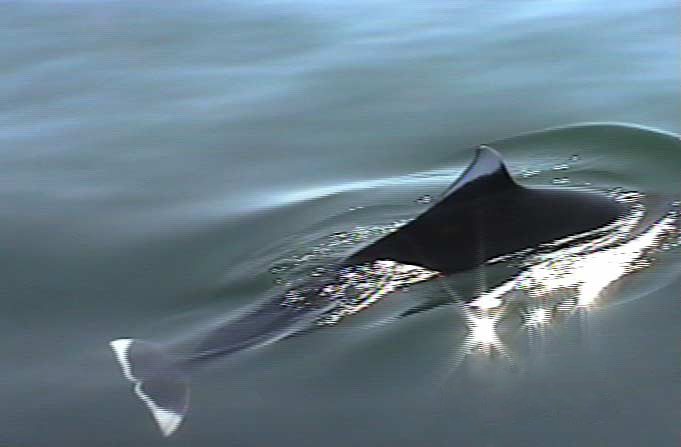This is the question asked by the The Humane Society
of the United States (HSUS) and other organizations concerned about animal
welfare. A growing body of evidence strongly indicates that captive
marine mammals, most especially cetaceans (whales, dolphins, and porpoises),
have a difficult time living in confinement. For example, humans
have kept bottlenose dolphins in captivity for over 50 years. Yet,
despite increased knowledge of these animals, we have either not learned
how to care for them in captivity, the dolphins cannot adapt well to a
captive situation, or both. Even after half a century, both captive
bottlenose dolphins and orcas have higher mortality rates in captivity
than in the wild (DeMaster & Drevenak 1988).
 |
The HSUS makes several arguments in their book, The
Case Against Marine Mammals In Captivity (1995), for the proper treatment
of all captive marine mammals and the potential release of some individuals.
This kind of thinking has created a rift between public display organizations,
such as oceanaria and aquariums (who want to keep their animals or obtain
more), and animal welfare groups such as The HSUS (who would like to release
captive cetaceans). The case against marine mammals in captivity
is as follows:
1. As noted above, cetaceans survive better
in the wild than in captivity. This is contrary to almost all animal
species in captivity. Birth rates are also an issue. In the
past 30 years, over 130 orcas have been in captivity and produced only
12 calves (NMFS 1994). During that time, at least 21 calves were
aborted, stillborn, or died soon after birth. For captive orcas,
birth rates have been lower and calf mortality higher than orcas living
in the wild.
|
How Smart Are Dolphins?
At the end of the observation session, the observer stood near the viewing
port and looked into the dolphin tank. The dolphins swam slowly around
the tank; the mother and calf just ahead of another adult female.
As the group swam by the window, the calf stopped and looked at the observer.
The observer inhaled from his lit cigarette and playfully blew smoke against
the glass. He was astonished when the animal immediately swam off
to its mother, returned and released a mouthful of milk that produced a
cloud similar to that of the cigarette smoke (Taylor & Saayman 1993). |
2. Government standards for tank sizes and
animal maintenance are inadequate and are not specific to the species,
i.e., species from tropical and temperate climates can be housed together.
Not enough is known about cetaceans to house them adequately. In
fact, what is known indicates strongly that cetaceans would not (and do
not) do well in a captive situation. The cetaceans typically in captivity
are bottlenose dolphins and orcas. Both species are far-ranging,
fast-moving, and deep diving. They can travel up to 100 miles each
day, reach speeds of 30 mph, and dive several hundred feet. They
are also acoustically superior to humans, intelligent, and socially complex.
Keeping them captive cannot remotely simulate their natural habitats.
Similar captive situations have been observed in wolves (Mallonée
& Joslin 2004) and other terrestrial animals (Hediger 1950).
3. No captive marine mammals are allowed
to hunt or forage, behaviors that may be important to the animals’ physical
and psychological health. Restriction of these behaviors in marine
mammals, in addition to other types of captive animals, can result in maladaptive
behaviors such as pacing, swaying, self mutilation, and severe aggression
toward humans and other animals (Carter 1982).
Public attitudes about captive cetaceans, however, have
changed. Keiko, the orca who starred in the movie Free Willy,
was released back into the wild after many years in captivity - a first
for amusement park animals. Although he eventually died of respiratory
problems, Keiko paved the way for future releases of captive marine mammals
and perhaps those of other species as well.
For information about wolf captivity,
please read the published study about Tenino, the wolf from the wild
placed into captivity. A magazine article is also available about this study.
References
Carter, N. 1982. Effects of psycho- physiological
stress on captive dolphins. International Journal for the Study
of Animal Problems, 3, 193-198.
DeMaster, J. & Drevenak, J. 1988. Survivorship
patterns in three species of captive cetaceans. Marine Mammal
Science, 4.
Hediger, H. 1950. Wild animals in captivity:
an outline of the biology of zoological gardens. New York:
Dover Publications, Inc.
Mallonée, J. S. & Joslin, P. 2004.
Traumatic stress disorder observed in an adult wild captive wolf (Canis
lupus). Journal of Applied Animal Welfare Science, 7(2),
107-126.
NMFS. 1994. The marine mammal inventory
report (June).
Rose, N., Farinato, R., Grandy, J. & Forkan, P.
1995. The case against marine mammals in captivity.
Washington, D.C.: The Humane Society of the United States.
Taylor, C. K. & Saayman, G. S. 1973. Imitative
behaviour of Indian Ocean bottlenose dolphins (Tursiops aduncus) in captivity. Behaviour, 44, 286-297.